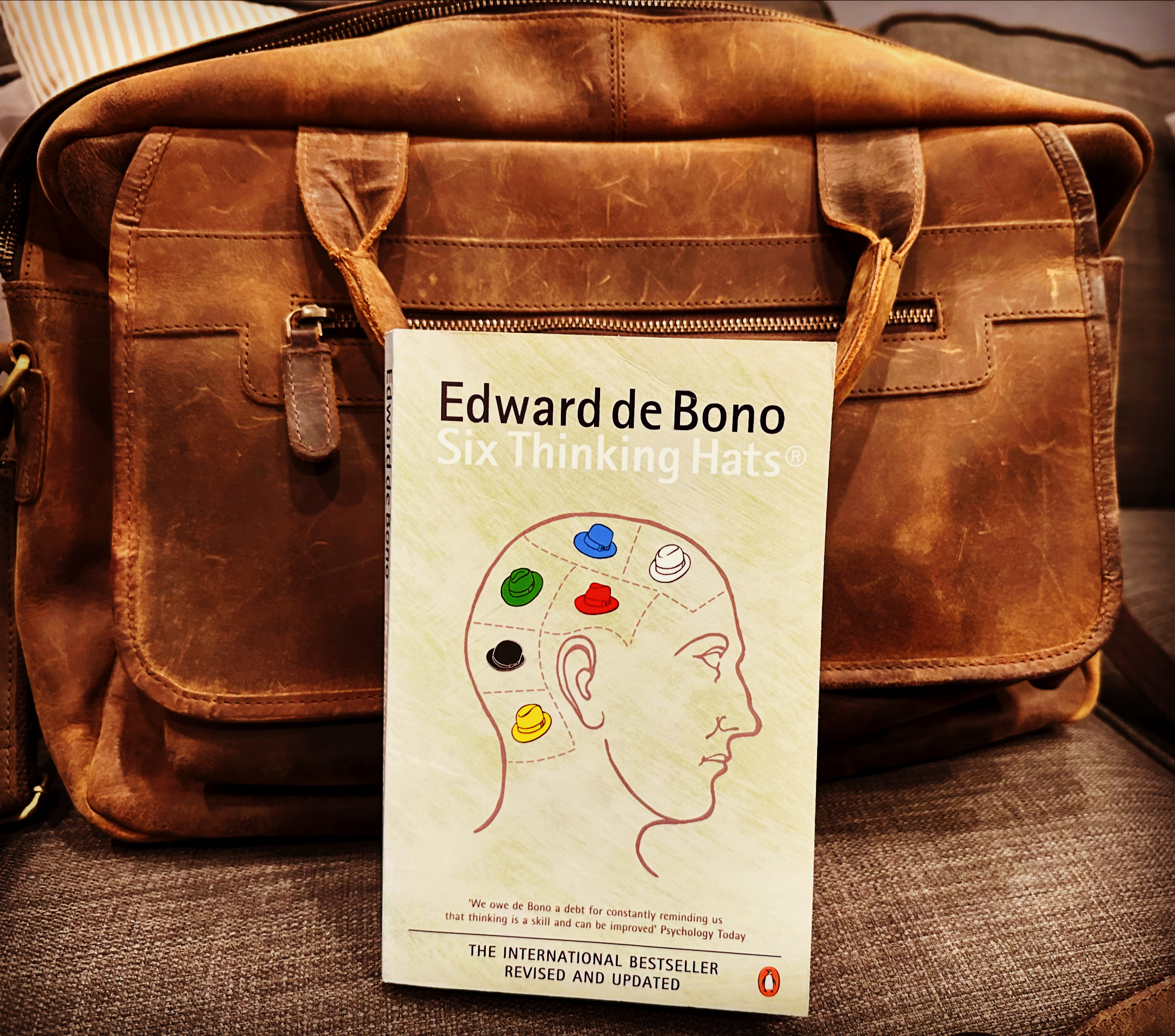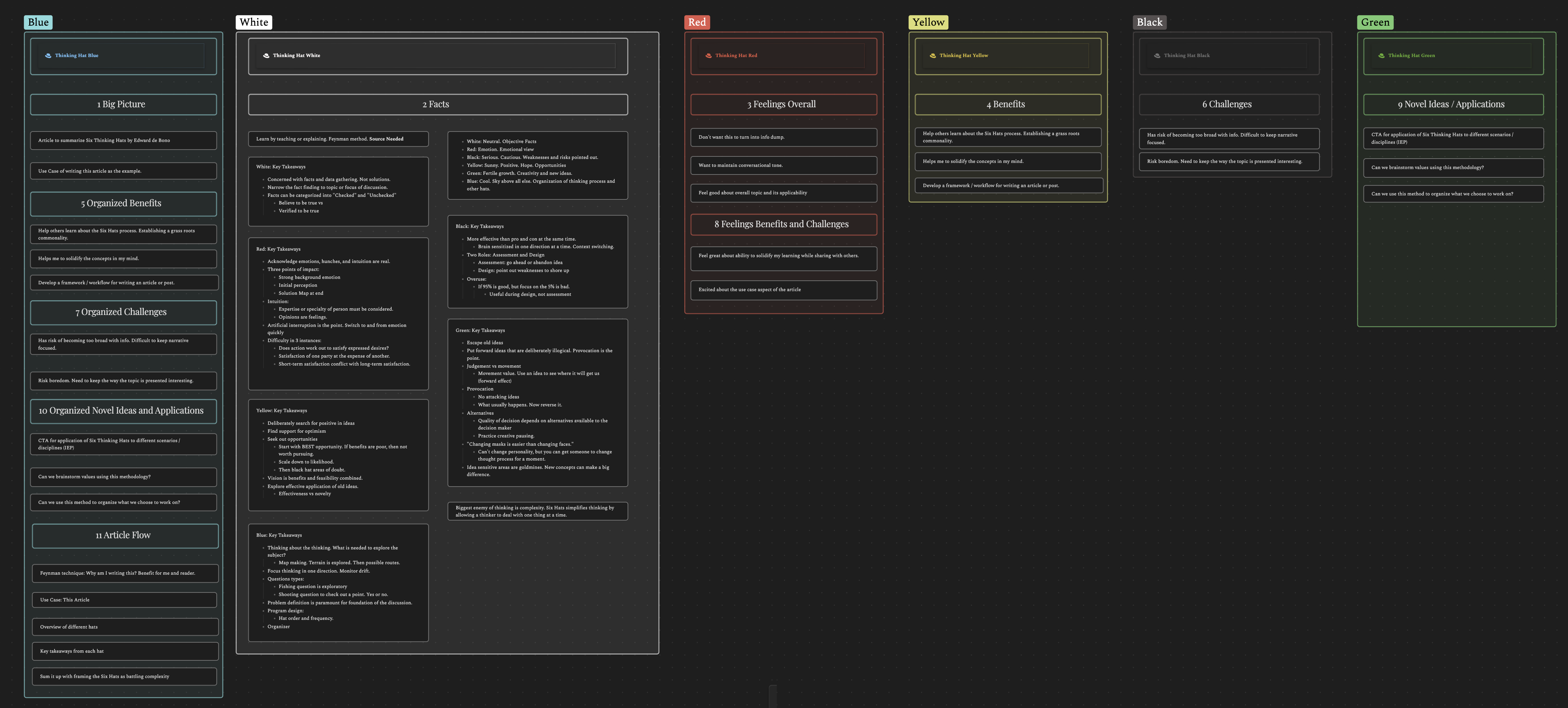I am on a mission this year to retain more knowledge. In my twenties, I was obsessed with hoarding facts and reading as many books as possible. This was great, in my twenties. I could spout off facts that seemed impressive but were ultimately shallow. As I grow older, I want to conceptualize the knowledge I gain into actionable outcomes. It is no longer enough for me to know about a concept. I want it to make a real and lasting impact on my life. One of the best ways to do that is to explain it to others through writing. This is one of those attempts.

The Six Thinking Hats Methodology
I recently read a book by Edward de Bono called “Six Thinking Hats.” In the book, de Bono covers the Six Thinking Hats methodology for thinking through a desired outcome. It’s an exciting concept that builds in “interrupts” to a more free-thinking flow to focus the thinking on specific angles. It has the potential to be highly effective, but I need to experience the methodology in practice before I can make a judgment. So, as a first experiment, I used the Six Thinking Hat methodology solo to brainstorm and write this article.
A Hat for Every Thought
Changing masks is easier than changing faces. -Edward de Bono
We all have built-in biases and ways of thinking about the world. It is part of our personality. While it is challenging, if not impossible, to change a personality, it is possible to focus thinking in a different direction temporarily. This is precisely what the Six Thinking Hats proposes. By formally announcing (to yourself or others when working collaboratively) that you are wearing a specific hat, a focusing effect will guide your thinking along the right path. Here are the six hats:
- White: This hat focuses the thinking on surfacing objective facts. Gather the data.
- Red: This hat focuses on the emotional aspects. How do you feel about the project, solution, or idea?
- Black: This hat is used to focus the thinking on risks or weaknesses. What are the risks of implementation? What are the weaknesses of the proposed solution?
- Yellow: This hat focuses on thinking about possibilities. This hat is all about optimism. The art of the possible.
- Green: This hat is used to focus the thinking on new ideas or solutions. Think of fertile growth.
- Blue: This hat organizes all the other hats and maps out a plan for the proposed thoughts and solutions. Think of the blue hat as the orchestrator. The surface concept of each hat is easy to understand, but I appreciated de Bono’s deep dive into each hat. The analysis offered some interesting perspectives on focusing your thinking using each hat and the associated outcomes.
White Hat
When “wearing” the white hat, the focus should be on facts and data gathering instead of solutions. How much do we know about the topic? What facts do we have? It is easy for a discussion to go down a rabbit hole of “what ifs” and solution design. I appreciate the white hat’s focus on objectivity and facts. There is a time for solution design, but only once as many facts as possible about the specific topic of discussion are known. Another critical aspect of the white hat discussion is categorizing facts into “believed to be true” and those “verified to be true.”
Red Hat
When “wearing” the red hat, the focus is on acknowledging that emotions, hunches, and intuition are real and should be explored. Emotion has three main points of impact.
- Strong background emotion. Start with the red hat if the topic is controversial.
- Initial perception. It might be helpful to “take a pulse” on how the team (or yourself) is feeling at the start of the brainstorming session and at the end.
- The overall solution map. It is helpful to gauge how the team feels once a solution has been decided upon and mapped out. When discussing intuition, it is essential to consider the expertise or specialty of the person bringing up the intuitive point. Does the person have some unique experience in the topic domain? If not, the intuition should not be as strongly supported.
It can be helpful to keep the following in mind when considering the red hat thinking process:
- Does the proposed action satisfy expressed desires?
- Does the proposed action satisfy one party at the expense of another?
- Weigh carefully the tradeoffs of short-term and long-term satisfaction. Emotions can lead the discussion off track quickly. The built-in interrupting mechanism of “putting on” the red hat allows the team (or yourself) to rapidly switch from emotion to other thinking directions.
Black Hat
When “wearing” the black hat, the focus is on risks or weaknesses in the idea or solution. Focusing on just this aspect is more effective than looking at the pros and cons simultaneously, as the brain can only focus on one of those directions at a time. Context switching kills a productive discussion. The black hat serves two roles:
- Assessment. Should we move forward or abandon the idea?
- Design. Point out the weaknesses to shore up with a particular idea or solution. It would help if you were cautious not to overuse the black hat. If 95% of an idea is good, focusing on the 5% that is bad is helpful in the design phase, not the assessment phase.
Yellow Hat
When “wearing” the yellow hat, the focus is on positive outcomes and opportunities. You are deliberately seeking out opportunities that exist with the idea or solution. You can also explore the practical application of old ideas. However, it is essential to also support optimistic standpoints. When seeking out opportunities, it can be helpful to do the following:
- Start with the best opportunity. If the benefits of the opportunity are poor, there is no reason to pursue it.
- Scale down to the likelihood of the opportunity.
- Finally, use the black hat to pinpoint areas of doubt. The vision of an idea or solution becomes the benefits combined with the feasibility.
Green Hat
When “wearing” the green hat, the focus is on “escaping” old ideas. Creative thinking is all about provocation. You must provoke your mind to focus on new ideas and perspectives. One way to accomplish this is to put forth deliberately illogical ideas. Another good exercise is to look at what usually happens and then reverse it. Finally, it can also be helpful to incorporate “creative pauses” into the thinking process to purposefully interrupt the flow in the service of creative thinking.
It is essential during green hat thinking to abstain from attacking ideas. When wearing the green hat, ideas should emphasize forward movement more than judgment. What can this idea do for us? You should also look for areas that are “idea-sensitive.” Idea-sensitive areas are areas where new concepts can make a huge impact.
Blue Hat
When “wearing” the blue hat, the focus is on thinking about the thinking. What is needed to thoroughly explore the subject? The blue hat focuses the thinking in one direction to ensure everyone is on the same page. Think of this activity as map making. First, the terrain is explored. Then, possible routes are examined. In this regard, the blue hat is also responsible for choosing the order of the hats in a given discussion. This can be fixed or fluid throughout the session.
Utilizing the Six Hats Method for Writing
When I first finished reading about the Six Hats method for thinking, my first use case would be organizing and writing an article for my website. I created a canvas in Obsidian and got to work.

Here is the order I followed:
- Blue. Big picture. What is my topic?
- White. Facts. What are the facts about my topic?
- Red. Feelings. How do I feel about the topic and my writing approach overall?
- Yellow. Benefits. Why am I writing this? What are the benefits to myself and my readers?
- Blue. Organize the benefits into a list.
- Black. Challenges. What are some of the challenges to writing the article? What are the weaknesses in my approach?
- Blue. Organize the challenges into a list.
- Red. How do I feel about the benefits and challenges I have come up with? Should they be developed further?
- Green. Novel ideas and application. An example might be a call to action (CTA).
- Blue. Organize the novel ideas and application of concepts into a list.
- Blue. Organize the article into a proper structure and narrative flow. I really appreciated this process more than I thought I would. What struck me as the most useful was the ability to simplify my thinking towards a specific outcome. When an idea first hits me, my mind wanders, essentially wearing all six hats simultaneously. I eventually can organize my thoughts into something cohesive, but the Six Thinking Hats methodology helped me achieve the desired outcome much quicker.
Overall, this initial experiment was a success, and I’m looking forward to utilizing this process on other projects. A couple of ideas that I am thinking about running through this process are:
- Value mapping. Can I figure out my core values by using this brainstorming process? What order should I utilize?
- Priorities. Can I use this process to prioritize what I work on at any given interval?
What other use cases can you think of?
You can follow my other writing and connect on social media by exploring the links at harleystagner.me
